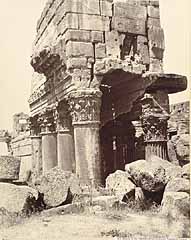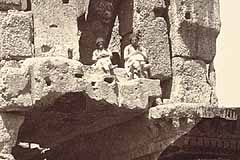November 2003 AT KANTAR FINE ARTS
Reception Sunday,
November 9 from 2-5pm
Thru a Distant Lens, a
special exhibit of vintage 19th c. photographs of Europe, the Middle
East, and the Orient, from the well-known collection of Dr. Daniel
Tassel, opens on Sunday, November 9, with a reception from 2-5pm, at
which the collector will be present.

|
Balbek by Bonfils |
The exhibit will continue through December 14,
2003. The exhibit features original albumen prints from glass plate
negatives by famous 19th century photographers, including Frith, Frank
Mason Good, Bonfils, Beato, Bourne and Scowen. The prints are part of a
larger collection that is noted for the excellent quality of each print.
Photographs from Dr. Tassel's acquisitions, collected over a period of
two decades, are included in the collections of Harvard's Fogg Museum
and Fine Arts Library, the DeCordova Museum, the Worcester Museum, the
Israel Museum in Jerusalem, and the Tel Aviv Museum. A number of
photographs from the collection were exhibited in the recent Fogg Art
Museum show, "Sight-seeing: Photography of the Middle East and its
Audiences."

|
Balbek by Bonfils (Close up) |
Dr. Tassel became interested in collecting important vintage 19th
century photographs when he traveled to Israel in the early 1980's, and
became involved in a re-photography project, utilizing some of the same
images from the 19th century while photographing various sites from the
same vantage point. Some of his own photographs are in the Jewish Museum
and the International Center of Photography, in New York City.
Thru a Distant Lens continues through December 14, 2003.
Gallery hours are flexible, and by appointment. For more information,
please call 617-332-7495 or 617-504-7596, or visit
www.kantarfinearts.com.
The gallery is open by appointment. We are located at 382 Kenrick
Street, Newton MA, off Waverley Avenue, about one mile from the Mass
Pike.

About the Photographers whose works are exhibited currently at Kantar
Fine Arts...
FRANK MASON GOOD
An Englishman, Good traveled to the Near East during several trips in
the mid-1860’s and early 1870’s. His images were exposed on glass plate
negatives, using the wet collodion process, printed on albumen paper,
and then gold toned. His unique work often made use of a second negative
to include a credible sky.
A number of Good’s photos were marketed by Francis Frith, in the Frith
Series, have an accompanying biblical quote, and are unsigned. Many of
his remarkable images are signed F.M. Good or FMG in a monogram on the
glass plate negative.
Good’s views are beautifully composed. They often include natives and
tourists, adding a touch of charm to the scene. He is considered by many
collectors and historians to be the best of the 19th c. Near East
photographers.
FRANCIS FRITH
Francis Frith arrived in Egypt in September 1856 to photograph its
ancient monuments and exotic sites. Over the next several years, he
returned twice to Egypt and Nubia and also traveled to Palestine,
capturing on his glass plate negatives the places depicted in the Holy
Bible.
Well composed and printed on fine albumen coated paper, his images were
widely acclaimed and tremendously popular. Frith founded a major
photographic business and hired photographers, including Frank Mason
Good, to record the Near East and Europe for his eager public.
Frith’s prints are in every major private and museum collection of the
19th century Near East photography.
ANTONIO BEATO
Antonio Beato opened his photographic studio and business in Cairo in
1862. He used the glass plate wet collodion process negative, and
printed his views on thin paper coated with egg white (albumen).
Until almost thirty years later, and the introduction of the first Kodak
camera, tourists were unable to snap their own pictures, and eagerly
sought out Beato’s architectural, landscape and genre scenes. These were
the postcards of the 19th century. At home, these images were often
pasted in an album, and provided, for family and friends, a detailed
tour of an exotic adventure.
Antonio Beato prints of this quality are rarely, if ever, seen, even in
museum collections.
GEORGIO SOMMER (SOMER)
Georgio Sommer, a German-born photographer, officially began his career
with the opening of his studio in Naples in 1857. Within several years,
he had formed a partnership with Edmondo Behles.
Sommer photographed widely throughout Italy and Sicily and surrounding
countries, was highly acclaimed, and was appointed photographer to King
Victor Emmanuel. His images range from the documentation of ancient
archeological sites to whimsical views of locals engaged in everyday
life.
Sommer’s excellent photographs remarkably document 19th century Italy
and Sicily.
FELIX BONFILS
Felix Bonfils and his wife, Marie-Lydie, moved from Languedoc and set up
their studio in Beirut, Lebanon, in 1867, starting the most successful
photographic business in the Near East. After the death of Felix in
1885, his son, Adrien, and his wife, Lydie, continued the business into
the early 20th century.
Gold toning frequently added a richness to the range of tones produced
by their glass plate negatives and fine albumen prints. Their views
included ancient monuments, biblical sites, genre scenes, and a number
of posed studio images, the latter often tinged with a bit of humor.
Despite their huge production, many of their images are unique and show
the changing landscape over a period of several decades.
CHARLES T. SCOWEN
Charles T. Scowen arrived in Ceylon in the early 1870’s, and within
several years, opened his very successful photographic studio and
business.
Scowen’s startling images of this distant land capture expansive
landscapes as well as the innate beauty of its exotic botanical
specimens. The native population is seen at work and at home in his
luminous prints.
These photographs by Scowen are in major collections, including the
Boston Museum of Fine Arts, the Getty Museum, and the New York
Metropolitan Museum.
SAMUEL BOURNE
Samuel Bourne began photographing in his late teens in the Midlands of
England. An adventurer, keen observer, gifted writer, and meticulous
craftsman, his talent was recognized at an early age.
By 1963, at age 29, he was photographing throughout India. He soon
founded a successful partnership with Shepard (Bourne & Shepard), which
continued until his return to England in 1869.
His luminous prints record a remarkable Indian landscape.


